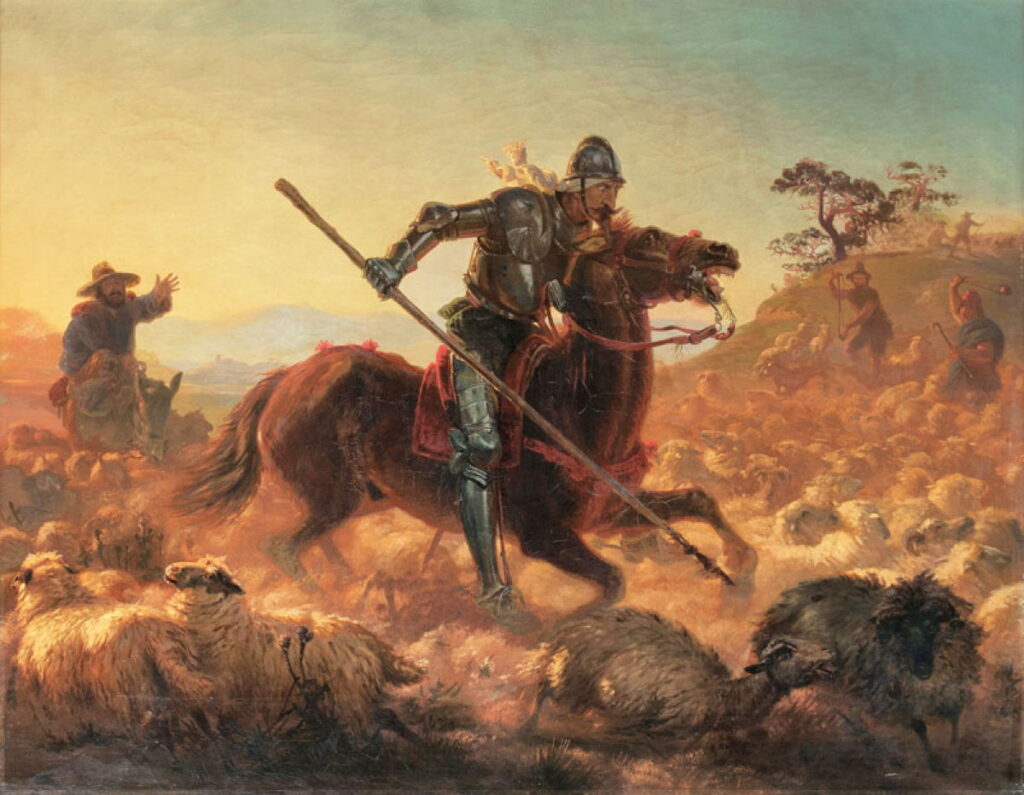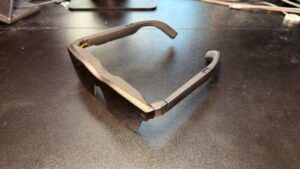Painting Don Quixote: Arise the knight

Telling a story in a painting intended to be viewed independently of its literary account requires great skill. Illustrations have the advantage that they’re going to be seen alongside the words, but a narrative painting could be exhibited almost anywhere. The most popular solution is to depict the best-known myths and legends, typically from classical times, stories that all educated viewers should be familiar with.
Painting a modern novel is even more of a challenge, making those showing Miguel de Cervantes’ epic Don Quixote, published in 1605 and 1615, among the boldest of all narrative paintings. A few years ago I published a long series of summaries of the book accompanied by paintings and illustrations. This weekend I look at just the former, from outside the immediate context of the literary account, considering whether they work as narrative paintings.
Mariano de la Roca y Delgado (1825–1872), Miguel de Cervantes imagining El Quixote (1858), oil on canvas, 171 x 210 cm, Museo Nacional del Prado, Madrid, Spain. Wikimedia Commons.
Cervantes himself spent at least two periods in prison, and it’s claimed that he started work on Don Quixote during the second of those. Mariano de la Roca’s painting of Miguel de Cervantes imagining El Quixote from 1858 may be as fictitious as the book, but reveals a clear vision of the knight and his squire, Sancho Panza. Their mounts are caricatured, but Don Quixote is fully detailed complete with the barber’s basin he wears as a helmet.
Nils Kreuger (1858–1930), Don Quixote’s Horse Rosinante (1911), oil on cardboard, 50 x 63 cm, Nationalmuseum, Stockholm, Sweden. Image by Bodil Karlsson, via Wikimedia Commons.
Nils Kreuger’s portrait of Don Quixote’s Horse Rocinante from 1911 is non-narrative, but nevertheless a fine painting, with the knight seated against the base of a tree and staring into the distance.
Quixote’s first, solo and briefest sally takes him to an inn, where he insists the innkeeper dubs him as a knight, as depicted by Valero Iriarte, who is now known almost exclusively for his paintings of this book.
Valero Iriarte (1680–1753), Don Quixote at the Inn (c 1720), oil on canvas, 54 x 78 cm, Museo Nacional del Prado, Madrid, Spain. Wikimedia Commons.
Iriarte’s first scene of Don Quixote at the Inn (c 1720) shows one of the earliest comic events in the book, in which the landlord pours wine into a hollowed-out length of cane to enable the aspiring knight to drink through his helmet. Immediately beforehand, the two women had fed him, as his hands had been fully occupied in holding up his cardboard visor. To anyone familiar with the opening chapters of Cervantes’ book, this would have been instantly recognisable.
Valero Iriarte (1680–1753), Don Quixote Dubbed a Knight (c 1720), oil on canvas, 54 x 78 cm, Museo Nacional del Prado, Madrid, Spain. Wikimedia Commons.
Iriarte’s second scene is set inside the inn, with Don Quixote Dubbed a Knight (c 1720). Quixote is on his knees ready for the ceremony, while the fat innkeeper stands behind with his back to the viewer, busy rehearsing his reading. To the left of Quixote is a young lad holding a candle, and a prostitute is holding the knight’s lance as she’s negotiating with her next customer, to the right. Again, Iriarte tells the story true to Cervantes’ account, and it’s readily recognisable.
After a couple of tragi-comic adventures, Don Quixote returns home battered and bruised.
Wilhelm Marstrand (1810–1873), Don Quixote’s First Ride Home (date not known), oil on canvas, 85 x 125 cm, Nivaagaards Malerisamling, Nivå, Denmark. Wikimedia Commons.
One of his neighbours came past with a donkey, on which the knight was placed. To avoid any embarrassment, they don’t enter the village until after dark. Wilhelm Marstrand’s undated painting captures the sense of defeat during Don Quixote’s First Ride Home.
Don Quixote recruits Sancho Panza to be his squire during the fortnight he spends at home after that first sally. The pair then ride out together and engage in the most famous of their adventures, when Quixote attacks a windmill, convinced that it’s a giant.
José Moreno Carbonero (1860-1942), Don Quixote and the Windmills (c 1900), oil on canvas, 290 x 279 cm, Museo Nacional del Prado, Madrid, Spain. Wikimedia Commons.
José Moreno’s painting of Don Quixote and the Windmills from about 1900 portrays the climax perfectly, as the knight and his charger are hoisted aloft by one of the windmill’s sails, as it rotates with the wind.
Don Quixote and Sancho Panza then endure further misadventures, during which the knight loses part of his helmet and some of his left ear. They accept the hospitality of some goatherds for the night, and the following morning attend the burial of a local scholar whose death resulted from his unrequited love for a young shepherdess. She appears at the burial and denies responsibility, as painted by Cecilio Pla and Valero Iriarte.
Cecilio Pla (1860–1934), Marcela the Shepherdess (1905), further details not known. Wikimedia Commons.
Pla’s Marcela the Shepherdess from 1905 shows her standing defiantly above the scholar’s grave.
Valero Iriarte (1680–1753), The Story of Shepherds Grisóstomo and Marcela (c 1701-44), oil on canvas, 162 x 220 cm, Museo Casa de Cervantes, Valladolid, Spain. Wikimedia Commons.
Valero Iriarte’s Story of Shepherds Grisóstomo and Marcela (c 1701-44) is overambitious in its detail. The shepherdess stands at the far right, well away from the burial taking place at the far left. Between them are Sancho Panza and Don Quixote, engaged in conversation.
The pair become involved in further unfortunate incidents, culminating in Don Quixote leaving an inn without paying for their accommodation. The knight then makes another spectacular error when he mistakes flocks of sheep for armies about to join in battle, a story that sticks in the mind.
Johann Baptist Zwecker (1814–1876), Don Quixote (1854), oil on canvas, 71 x 91 cm, location not known. Wikimedia Commons.
As Johann Baptist Zwecker shows in his painting of Don Quixote from 1854, the knight then charges at the armies of sheep with his lance, to the annoyance of the drovers, who retaliate by knocking out several of his teeth with their slingshot.
A turning point in this second sally occurs when the pair free a dozen convicts who turn on them by bombarding them with rocks, then run away. Fearing that they are in danger, the knight and his squire ride off to hide in the mountains, as shown below in Adrien Demont’s painting of Don Quixote from 1893.
Adrien Demont (1851–1928), Don Quixote (1893), oil on canvas, 111 x 156 cm, National Gallery of Victoria, Melbourne, Australia. Wikimedia Commons.
Tomorrow I’ll show paintings of what happened next.

